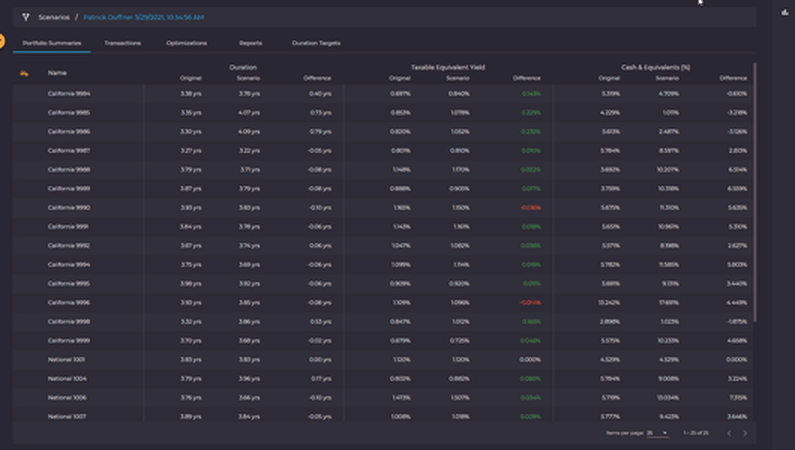Fixed Income Trade Allocation: How Technology & Automation Ensure Equitable Bond Allocation Processes

Fixed income portfolio managers are regularly faced with the challenge of allocating new bond issues across client accounts. Incorporating clients’ portfolio targets, investment policy statements, available cash, and other important criteria can be time-consuming and error-prone. To complicate matters further, final allotments should be both fair and optimal.
The need for bonds can arise in times of strong or weak issuance
To set the stage, it goes without saying that issuance in both the corporate and municipal bond markets can be sparse or plentiful, or somewhere in between. As one example, SIFMA investment grade corporate bond issuance in August 2024 was over 150% greater than in August 2023, but August 2024’s total was just 53% of February 2024’s issuance.
But a need to invest new cash, rebalance to a revised model portfolio, or respond to changes in duration or sector targets based on a new economic outlook does not necessarily line up with the optimal timing for buying new issues based on the corporate or municipal bond calendar. Trading desks may participate in new issues as they come to market, often referred to as unsolicited orders, and portfolio managers must then decide how best to allocate the bonds.
The challenges in allocating bonds across accounts
Regardless of whether expectations for new issuance are high or low, allocating bonds across portfolios is always challenging. Portfolio managers typically have a manual, time consuming process to work account-by-account to determine a “fair” allocation, which needs to hold up to internal and external audits. In particular, having rules for each account housed in different places makes it challenging to ensure an allocation is accurate and not violating any rules.
When it comes to allocation, two important questions to answer are “which portfolios?” and “how much?”
- Identifying where to allocate a new trade: Portfolio managers have to determine which portfolios can absorb part of a new issue allocation, and while a bond’s characteristics may be appealing in general, it will only be a fit for some portfolios. That fit depends on available cash, exposure targets, and investment policy restrictions with respect to duration, sector diversification, credit ratings, issuer concentration, and so on. Verifying all of the necessary checks is incredibly tedious, especially when information is stored in various places. Given the time pressure involved when there is a good offering available, mistakes are not uncommon. It is critical to have technology to filter down to accounts that are the most optimal for a specific issue.
- Deciding how much to allocate to each portfolio: After determining the portfolios, PMs need to allocate quantities across those accounts based on the final allotment. Fairness is important here, but so is achieving optimal outcomes across accounts. While making pro-rata allocations (based on the actual allotment as a percentage of the total amount requested) is fair, it is not necessarily optimal. For example, the pro-rata approach may cause some portfolios to end up holding very small lots, which may not move the needle in terms of achieving a specific goal and does not make sense from a liquidity perspective.
An approach to ensure equitable allocation
Often, a better approach is to use a customized waterfall logic, which the IMTC allocation tool can run on-the-fly for an immediate assessment. This allocates new issues according to each eligible portfolio’s relative need, based on criteria that users define. For example, “need” might be determined by a portfolio’s distance from its target in terms of duration, sector weightings, or credit quality. For munis, need could be based on the benefit each portfolio would derive from holding bonds from specific states. Or one could choose to give the highest priority to portfolios that have held the most cash for the longest period of time. For secondary market issues, the IMTC allocation tool also allows users to give preference to portfolios that already hold some of the issue, as doing so would improve the liquidity of the overall position.
A user-defined, rules-based approach to allocation results in a much more equitable allocation process that adheres to compliance rules without fail.
Allocation automation = timeliness + accuracy + transparency
Clients have stated that using IMTC’s allocation tool makes their process 5-6x faster than when they handled it manually and improves their confidence in the outcome. On average, IMTC’s clients have been able to reduce the time they spend allocating trades by 80%.
Using an automated, algorithm-based allocation saves time, minimizes errors, and eliminates subjective instincts or assumptions. It ensures portfolios move closer to targets and remain in line with investment policy statements and compliance rules.
By automating the process, managers can confidently determine which portfolios could absorb the new issue based on whatever criteria may be relevant, from available cash positions to tax loss harvesting goals, exposure targets – either stand-alone or relative to a benchmark – and policy constraints.
IMTC’s allocation functionality allows portfolio managers to allocate however a trade occurs naturally. PMs can run a solicited or unsolicited trading workflow.
- Solicited trading workflow: A portfolio manager determines accounts in need of a trade, run an Optimization and find optimal bonds, and the allocate based on the availability.
- Unsolicited trading workflow: A portfolio manager secures a trade and then needs to determine accounts in need and quantities for each account.
IMTC’s allocation tool allows portfolio managers and compliance teams to clearly understand what each portfolio would look like after a trade, before the allocations are finalized. It also creates an audit trail to show that a trade is in compliance with target objectives and investment policy statements.
Connectivity into trading platforms and execution venues as well as custodians and brokers enables straight-through-processing and streamlines the flow of data downstream. Once a trade is executed, the allocation details are sent directly to custodians and brokers, resulting in a highly accurate process without manual intervention.
IMTC enables equitable allocation across accounts

In summary, IMTC’s allocation tool helps portfolio managers to:
- Equitably allocate a final allotment across portfolios based on selected criteria
- Identify portfolios that would be a good fit for a new issue allocation, faster
- Visualize the pre- and post-trade impact of a potential trade
- Adhere to target objectives and policy restrictions
- Minimize the potential for errors and mistakes
- Automate the flow of trade data to brokers and custodians
When these tools are used in conjunction with IMTC’s other decision support tools, portfolio managers have more time to do activities that add more value and deliver better outcomes for clients. See how IMTC’s Optimizer enables portfolio managers to make optimal decisions across accounts.





